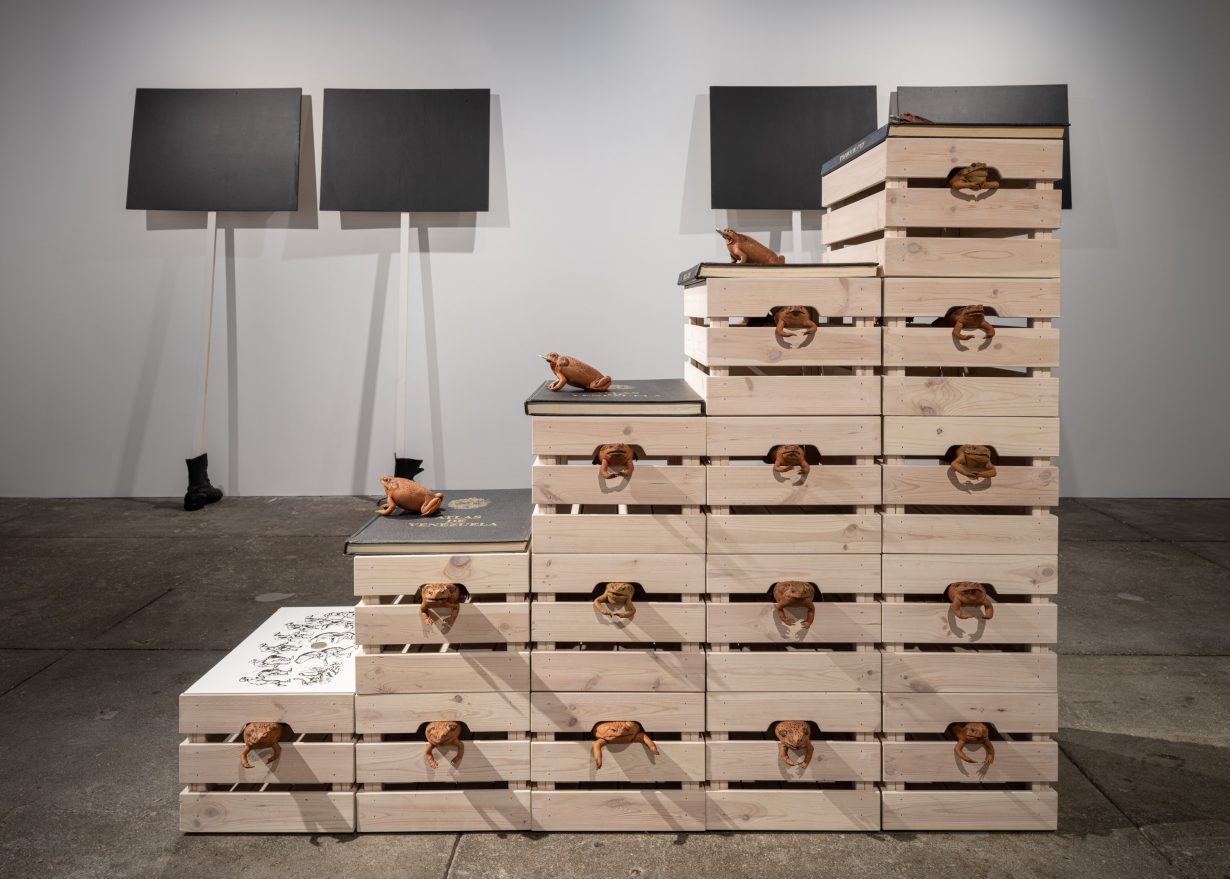From Chaplin and Kafka to the Atlas of Venezuela, Téllez’s new film Amerika examines our eroded political systems
A film plays in a dimly lit, carpeted gallery draped with velour curtains, one of three rooms occupied by the work of Javier Téllez. Emblematic of the New York-based Venezuelan artist’s broader practice, the film, AMERIKA (2024), cruises in the gaps between image and language, fact and fiction. The reference-packed 24-minute mise en abyme begins with a small audience attentively watching Charlie Chaplin’s The Immigrant (1917) in a setting the exhibition materials identify as Village East, a vintage Manhattan movie theatre. Suddenly, the audience members onscreen become characters in their own black-and-white film, migrants on a gloomy transatlantic sea voyage based on scenes from The Immigrant and Karl Rossmann’s exile from Europe in Franz Kafka’s novel Amerika (1927), which terminates at a port city much like New York. There, the migrants confront a Spanish-speaking authority figure reminiscent of the character Adenoid Hynkel in Chaplin’s antifascist satire The Great Dictator (1940), who decrees their deportation and jails them when they protest.
In AMERIKA, the process of being implicated by power is rendered farcical and fantastical by Téllez’s decision to cast his actors, eight Venezuelan asylum seekers currently living in New York, in dual roles. Each actor plays both a migrant and a fascist, categories separated by little more than a costume change in the film. The blurred line between oppressor and oppressed, presented innocuously at first as a facet of meta-cinematic intrigue, sharpens into a point of political self-criticism in the final scene, which shows the escaped migrants eating leather boots – a reference to Chaplin’s The Gold Rush (1925) – seated in the manner of Leonardo da Vinci’s The Last Supper (1495–98). Téllez’s allusion to Leonardo’s painting, which depicts the biblical passage in which Jesus predicts betrayal by one of his disciples, ominously hints that the migrants’ revolution in AMERIKA, too, has been compromised from within. Revolution in Téllez’s sense thus seems akin to a series of nonlinear transformations marked by repeated setbacks, cyclical implosions and reconfigurations of allegiance.

Recursivity is likewise explored in two assemblages in the neighbouring gallery. The first, titled Caminantes 1–4 (2024), consists of two politically charged props from the film, namely the migrants’ protest placards and leather boots. Like its formal reference, Dürer, ich führe Baader und Meinhof über die Documenta V (Dürer, I’ll Guide Baader and Meinhof Through Documenta V Personally, 1972), Joseph Beuys’s ambivalent tribute to the Red Army Faction, Caminantes 1–4 acts as an ambiguous stand-in for the migrants’ bodies. Moreover, visitors are invited to write on the blackboards. As a result, at any given time, the work presents a record of multiple simultaneous conversations; over the course of the exhibition, it becomes a palimpsest of politically charged slogans, written, erased and rewritten by countless anonymous hands.
In the second assemblage, Salta Lenin el Atlas (2022), titled after a cartographically evocative Spanish palindrome that translates as ‘Lenin jumps over Atlas’, taxidermy cane toads, historically exported to the West for pest control and now considered pest in their adopted homeland, peer out from the slats of 15 wooden crates stacked like a staircase in the centre of the gallery. These amphibians are juxtaposed with a nineteenth-century illustration of children leapfrogging, pasted atop the starting step of the ‘stairs’. Soviet coins wedged in the toads’ mouths and four oversize copies of The Atlas of Venezuela (1969) – a collection of maps produced in the democratic period preceding the country’s authoritarian resurgence – point to how eroded political systems might survive, however provisionally, in books and visual culture. Here, as in all of Téllez’s works on view, a dense web of citation models one way to safeguard oppositional histories against contemporary amnesia.
Amerika at Research and Alliances, New York, 1 June – 11 August
